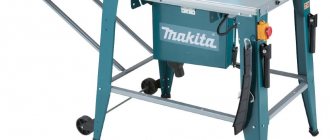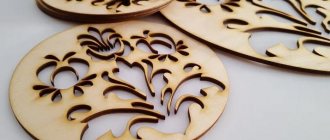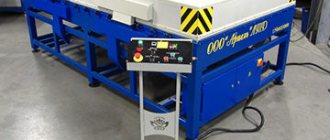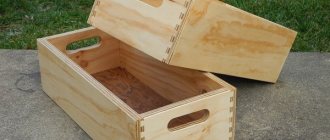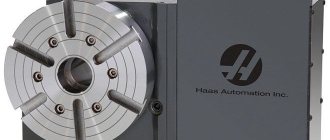When renovating or building, making furniture, and in other situations that require processing lumber, you may need a circular saw. Craftsmen who work with wood note that a sawing table is much more convenient and safer to use compared to a hand saw. Moreover, the accuracy of performing actions is much higher. You can make such a machine with your own hands - it is often more profitable and faster. In addition, a self-made design will more accurately meet the requirements of the master.
Design Features
Structurally, a homemade sawing table looks quite simple. The machine consists of a supporting frame for mounting the motor, a transmission unit and a work table with a slot for the cutting disk. The design is equipped with stops for guiding the workpiece and a protective screen that prevents chips from entering and also increases work safety.
Mandatory requirements for a sawing table:
- rigid, stable design;
- smooth surface of the tabletop;
- secure disk mounting;
- fencing protecting the operator of the machine (table);
- easy access to the control device (start and stop buttons).
The equipment must be installed on a frame supported not on solid sheets, but on legs. This improves ease of use, although it makes the saw table less stable. To increase durability, the frame can be made of metal or reinforced with metal elements. Safety is ensured not only by the protective screen, but also by securing the disk from the bottom (inner) side. Additional requirements depend on the specifics of the work - auxiliary elements help to process parts more accurately, saw longer boards, as well as thick logs.
By making a saw table with your own hands, you can get a number of advantages - from reduced costs to the ability to change the design as the master needs it. If desired, you can replace some of the parts with more economical ones, or use materials left over from repairs or construction. The only disadvantage of a circular saw independently fixed to the machine is a decrease in the accuracy of workpiece positioning. But this moment still largely depends on the skill of the performer himself.
Rigid, stable construction
Smooth countertop surface
Secure disk mounting
Guard protecting the operator of the machine (table)
Folding sewing table
- The shelf to support the machine is smaller than the hole so cords can fit between the shelf and exit out the bottom of the table. The convenient design allows you to slide the shelf to support the machine back just enough so that the scraps fall through the gap into the waste bin below the table.
- When sewing, some machines require access to a lever to retract the feeders. The large opening and hinged top allow you to install an additional tray if you are not using the insert. The legs are removable and can be stored inside the frame.
- To increase the work surface, an additional rectangular sheet can be attached to the front of the machine. There are several options for resolving this issue. One was to build a drawer that slides out and supports the front sheet.
Materials
When assembling a cutting table from chipboard with your own hands, you should maintain an optimal balance between functionality, safety, time and money. This can be achieved by selecting parts and materials with the necessary parameters. It is possible to reduce costs by using old parts of other structures - furniture, frames of wooden houses and outbuildings.
Tabletop
The main requirements for a saw table are resistance to heavy loads, shocks and vibration. The tabletop must be smooth enough to move and not bend under a weight of 50 kg or more. Suitable options might be:
- Metal (steel or duralumin) 3–5 mm thick. The advantages of metal countertops are high strength, almost unlimited service life, the disadvantages are heavy weight, decent cost.
- Laminated chipboard or moisture-resistant plywood with a thickness of at least 2 cm. The cost of this option will be the most profitable, but the strength is noticeably reduced.
- Textolite 15–20 mm thick. The material is more durable than plywood, but inferior to metal. In terms of cost, textolite countertops are also between metal and plywood sheets.
Plastic, chipboard or OSB are not recommended as countertop materials. A structure made from this raw material will be unstable to vibration from the saw. It is possible to make a table entirely from natural wood, but it is too expensive.
You can reduce costs while increasing strength by using combinations of materials—for example, thick plywood covered with sheet metal.
Metal
laminated chipboard
Textolite
bed
At the base of the table for sawing boards there can be wooden beams, secured under the lid to increase rigidity. Elements with a cross-section of at least 5 x 5 cm are placed at a distance of 50–90 mm from the edge of the tabletop. For the sawing table, it is recommended to choose bars made of hard wood - beech, hornbeam, oak. The advantages of wood are low cost, easy installation using self-tapping screws. Disadvantages - less strength and service life, high probability of fire.
The upper part of the table frame for cutting chipboard and other materials is often made by hand from the same sheets that were chosen for the table top. For the legs of a wooden structure, it is recommended to use timber, securing it with metal corners. The pros and cons of wooden supports are similar to the features of a frame made of the same material.
The basis of the table for cutting and sawing boards can be metal. Stability increases when choosing metal corners or channels with sides of 25–50 mm. To save money, they are purchased at scrap metal collection points or replaced with profile pipes. The frame parts are connected by welding. The use of bolted connections is not recommended due to the possibility of loosening due to vibration. The reasons for choosing a metal frame are maximum strength, reliability, and easy maintenance. Disadvantages: high cost, need to use a welding machine.
Metal
Wooden beams
Plywood
laminated chipboard
Woodtec 3200 R – from 155,000 rubles
An upgraded version of the entry-level machine.
For cutting standard versions of wood-based panels, up to 5-10 sheets per day. The roller carriage ensures maximum precision and smooth running. Adjusting bolts are provided to remove the lateral play of the movable table. The welded frame determines the strength of the machine. The cast base of the saw unit prevents the occurrence of tool runouts throughout the entire life of the machine. The aspiration system housing is held by the riving knife, and the knife itself is not rigid enough to keep the housing from vibration. If the laminated chipboard is fed unevenly, this nuance can provoke a sharp increase in the amplitude of vibrations of the casing, its beating on the disk and trembling of the sawn board. This is why laminate chips even on high-quality material.
The first experience of working on this particular machine should be obtained only after professional adjustment.
Without a guaranteed correct setting, it cannot be turned on for testing - the same riving knife, due to its low rigidity, does not allow one to determine its weakened fastening even by touch. Which can cause damage to the blade, drive and saw unit. Technical characteristics of the Woodtec 3200 R format saw
| Characteristic | Meaning |
| Engine power (main / trim), kW | 4 / 0,75 |
| Disc Ø (main / scoring), mm | 315 / 120 |
| Disk rotation (main / scoring), rpm | 2 800, 4 000, 5 600 / 8 000 |
| Cut (length / depth at 90°(45°)), mm | 3200 / 80(65) |
| Machine dimensions (LxWxH (weight)), mm (kg) | 3200x3440x850 (900) |
Video about the Woodtec 3200 R panel saw:
Selection of dimensions
It is worth choosing the size of the sawing table depending on the square footage of the workshop. The small area of the room allows you to use a tabletop of 50 x 50 cm. Making the sawing table smaller does not make sense - it will be difficult to use it when processing long workpieces. The universal size, ensuring convenient sawing of laminated chipboards, is 80 x 80 cm.
The maximum recommended dimensions of the sawing machine are 120 x 120 cm.
To comply with safety requirements, it is recommended to place the saw in the middle of the tabletop at a distance of at least 25 cm from the edge - it is this indicator that leads to the minimum width of 500 mm. The location of the saw blade also depends on how it will be used. There are three types of design:
- for longitudinal sawing;
- for cross cutting;
- universal.
The depth and location of the disk installation depend on the workpieces processed on the machine. For boards and plywood, it should protrude above the tabletop by 50-80 mm, for logs - by 110-125 mm. The height of the upper part of the frame made of sheets of plywood or chipboard can be in the range of 35–40 cm. If you make the frame only from timber, this parameter depends on the cross-section. The remaining part of the structure consists of wooden legs, the size of which craftsmen usually choose to suit their height. The overall height of the sawing table is about 1.0–1.1 m, but can be reduced to 900 mm.
Ready-made solutions from the store
In addition to the simplest small beds for stationary work in the kits of some models, there are many other ready-made solutions on sale. Among them are folding workbenches priced from 1.5 to 10 thousand rubles, which can be adapted (modified) for working with a manual circular saw in a stationary mode.
Disadvantages of such solutions: folding workbenches are not designed specifically for circular saws and require modification. These are often flimsy structures, especially cheap ones, and may not be suitable in principle. Because they won't withstand the load.
There are also special tables that allow you to mount both a circular saw and other power tools: jigsaws, milling cutters. But the price for such products is high, sometimes more than 40 thousand rubles.
As an example, in the photo there is a WOLFCRAFT Master cut 1500 workbench:
Special tables are a serious decision, but at a serious price.
In addition, the special table has a small area. And when making a homemade version, it is possible to make a desktop of exactly the dimensions that a particular master requires for his tasks.
The important thing is that you can assemble both the simplest version of the machine and a more complex one - with a carriage (sled) that moves along guides, with a marking ruler along the edge of the table, etc.
Create a drawing
The first stage of creating a machine for processing wood is drawings of a sawing table. You don’t have to compile them by choosing the appropriate option on thematic sites or forums. But it’s better to make at least the simplest diagram yourself, taking into account the available materials and the selected sizes.
The drawing notes all the nuances that will be needed to prepare the materials, indicate the mounting locations for the supports and their angles of inclination if the table legs are not perpendicular to the table top. In the figure it is also worth noting the place for attaching the unit to turn the saw on and off. When drawing up a diagram yourself, maintaining scale and exact proportions is not necessary. The main thing is to correctly indicate the dimensions of all future parts for the sawing machine.
Holz-her 1270 – from 220,000 rubles
Format cutting machine with a vertical table – for transport cutting of dimensional slab materials.
Takes up minimal space. There is a semi-automatic feed of the saw unit with return to the starting position. The design allows you to quickly adjust the cut size and change the cutting axis in two movements.
Does not allow cutting a sheet of material diagonally.
Despite the pneumatic clamping of the workpiece to the table, it is inconvenient to cut and remove large parts alone. Please note: the design of the saw unit does not provide for a scoring disc. Therefore, only equipment recommended by the manufacturer is used. High-quality cutting using analogues of branded blades is possible only if it fully complies with the specifications of the “original” cutting part of the equipment. Technical characteristics of Holzher 1270
| Characteristic | Meaning |
| Motor power (saw/feed) kW | 3 / 0.35 and 0.55 |
| Pressure in the pneumatic system, bar | 6 |
| Disc Ø, mm | 220 |
| Disc rotation, rpm | 5 450 |
| Cut (height, length / depth), mm | 2 145, 5 300 / 50 |
| Machine dimensions (LxWxH (weight)), mm (kg) | 6315x1420x2890 (1050) |
Video about the Holzher 1270 panel saw:
Manufacturing stages
Before assembling the machine for cutting boards, logs and blanks, you should prepare all the necessary materials and tools. To work you will need:
- moisture-resistant plywood;
- sheet material suitable for making the body;
- elements for the body and legs (bars 40 by 40 mm).
Fastening will be done with self-tapping screws using a screwdriver. All necessary parts are cut with a jigsaw. A saw with a disk of suitable diameter is also prepared.
Algorithm for creating a table:
- Sawing all parts into pieces with the required dimensions.
- Marking the mounting areas for the saw and legs on the table top.
- Making a case, which is usually a rectangular box without a lid or bottom.
- Installation of countertops.
- Cutting a hole that should be 5–10 mm longer and 4–6 mm wider than the disc.
If you cut the material at a certain angle, the resulting slot should resemble a trapezoid (inverted) in shape. For smooth sawing, a regular hole is made. Before cutting out the groove, you should apply a saw and adjust the marks.
Sawing all parts into pieces with the required dimensions
Marking the mounting areas for the saw and legs on the tabletop
Case manufacturing
Installing the countertop and cutting the hole
Preparing to install the saw
Safety precautions during operation
Basically, the safety precautions for working with such a saw are the same as with a regular circular saw:
- the hand should not pass close to the saw blade; pushers for the circular saw are used;
- the possibility of clamping and discarding small workpieces should be anticipated;
- Be sure to wear safety glasses when working.
In addition, there are specifics.
- turning the saw on/off cannot be done using the standard button located on the handle of the saw. If you reach under the table for it, there is a chance that your hand will get caught in the rotating saw blade;
- The saw itself must be secured securely enough. If misaligned, the rotating saw blade may catch on the table, which will lead to unpredictable consequences.
In general, these machine options have their significant advantages and disadvantages.
Advantages: the hand-held electric saw itself is a ready-made saw unit with its own engine. It can be used both as a manual and as a stationary option.
It is possible to cut at an angle due to the function of adjusting the angular position of the platform. Sawing at an angle is only possible on fairly expensive traditional stationary circular saws.
Disadvantages: unlike a traditional circular saw with an asynchronous motor, such a machine cannot operate for a long time under heavy loads.
The complexity of the design and build quality of such machines can vary greatly. From hastily knocked together boards, nailed workbenches. To complex precision devices with slides, movable stops, screw adjustments, parallel bar fastenings, etc. However, it is quite difficult to make such fully functional machines, similar to factory-made stationary circular saws, at home. In addition, you will have to buy a lot of parts and components.
How to install the saw correctly
The next step is to properly position the saw on the top surface of the saw table. To do this, the contractor must perform the following actions:
- Install the tool so that its working part fits into the pre-prepared groove.
- Mark the locations for the M8 plowshare bolts with countersunk heads (they will be used to secure the saw blade).
- Drill the plywood from the top to make equal holes with a diameter of about 8 mm.
- Make a countersink to countersink the bolt heads.
- Carefully install the metal saw blade and carefully tighten the bolts from the bottom using nuts and lock washers.
The work of making a machine requires great concentration and concentration. The slightest mistake can lead to having to start all over again.
After securing the structure to the table, you need to install a block to turn the circular saw motor on and off. A hole is cut in the housing, the switch is secured with bolts and universal glue. There should be two separate cables coming from the unit. One to the instrument, the other to the nearest electrical outlet.
When assembling such a unit yourself, it is worth taking into account the performance of the motor, as well as the maximum power of the electric motor. In this case, experts advise choosing a motor whose power does not exceed 1000–1200 W, otherwise operation may be unsafe. And a more powerful saw means a heavier and more stable table.
Install the tool so that its working part fits into the pre-prepared groove
Mark the locations for the M8 countersunk plowshare bolts
Install the metal saw blade and carefully tighten the bolts from below
Install a block to turn the circular saw motor on and off
Which circular saw to choose for installation
Long cuts, for example when cutting boards into timber or cutting wane, require prolonged work under significant load. In this mode, only high-quality circular saws can serve for a long time.
The same is true when working in stationary mode. When the circular saw is turned upside down by the saw blade and secured in the table, it turns on and works for a long time. At the same time, the graphite brushes actively wear out, the contacts of the rotor and the gears of the transmission mechanism are erased.
Attention! To work in a stationary mode, you should choose a tool from trusted brands, semi- or professional class.
Optimal power is from 1.2 kW to 2.2 kW. There are large models with a power of up to 5.5 kW. But they are expensive and consume a lot of energy, and their power can be excessive.
Making stops
The last stage of making a sawing table with your own hands is installing stops. A standard part of most circular saws is a rip guide. Traditionally, the stop is made from an aluminum cornice or a wooden block. Its size is chosen so that the part runs across the entire table - parallel to the saw and from edge to edge.
Cross stops are also often used on sawing tables. They are used to cut parts at an angle of 90 degrees and trim boards. To make a stop, follow these steps:
- Prepare an ordinary plywood sheet 1 cm thick.
- Secure a block at least 2 cm high to it.
- Attach a second rail perpendicular to the first on the bottom side of the base.
- Cut off excess base.
The transverse stops are attached to the workpieces using clamps or fastening devices made from wooden washers. Such homemade clamps provide fastening of guides to parts of almost any width. If you fix the block on the underside of the base at an angle of 45 degrees, you get a corner stop. After all work is completed, the surface of the circular table can be treated with a grinding machine and coated with a layer of protective varnish. This will protect it from various mechanical damage, and in general will extend its service life.
Perhaps such a table does not look as attractive in appearance as a factory one. However, from a technical point of view, it is in no way inferior to it, so even a novice carpenter can safely take on its manufacture.
Prepare parts for the longitudinal stop
Assemble mounting brackets
Place the bar on the table
Clamp the crosscut pieces together
Attach the cross supports using clamps
Cross stop is ready
Convenient sewing table: ideas, drawings, arrangement nuances
- To prevent the saw teeth from damaging the laminated layer of material, adhesive mounting tape is glued to the cutting line;
- to facilitate the sawing process, with a sharp knife blade it is necessary to scratch the lamination layer until the layer of chips is reached, and the direction of the blade should be tangential to the surface of the material;
- During the sawing process, it is important to keep the saw blade at an acute angle of 30 degrees relative to the surface of the workpiece;
- when using power tools, work is performed at low speeds;
- on the finished part it is necessary to cut a thin layer of the laminated part at an angle of 45°;
- after cutting, the edge of the workpiece is processed with a file in the direction from the periphery to the middle;
- After the edge of the cut has been filed, it is covered with a self-adhesive overlay melamine strip, or it can be an edging in the shape of the letter C or T.
Tools needed to assemble the table: drill with drills M2, M6, file, hacksaw, wrench 13. To assemble the bedside table: drill with drill M5 and attachment or drill for confirmations, key for confirmations, awl.
- The wheels must be installed in such a position that when turning they protrude beyond the dimensions.
- When drilling holes in the ends, use a regular M5 drill bit
- The hinged lid can be secured in two ways: on two U-shaped slats or rings attached to the inside of the door.
Photo source www.liveinternet.ru/users/irma2/post151636364/
Sewing table, design, materials, master class on creating
When choosing a specific model, be guided by the following selection criteria:
Expert opinion
Strebizh Viktor Fedorovich, leading construction foreman
To make even simple furniture yourself, you need not only a set of carpentry tools, but also the ability to use them. If you want to clarify something, please contact me!
Conclusion
Due to the fact that the issue of choosing the right formatter is most acute for representatives of small businesses, let us summarize based on the needs of these customers.
the most acceptable option for starting production activities is the inexpensive Woodtec 3200 R. Its capabilities are sufficient for the leisurely production of cabinet furniture according to individual projects.
Altendorf F45 , due to its reasonable price and high cutting accuracy, in general terms outperforms even the most expensive representatives of format cutting machines.
